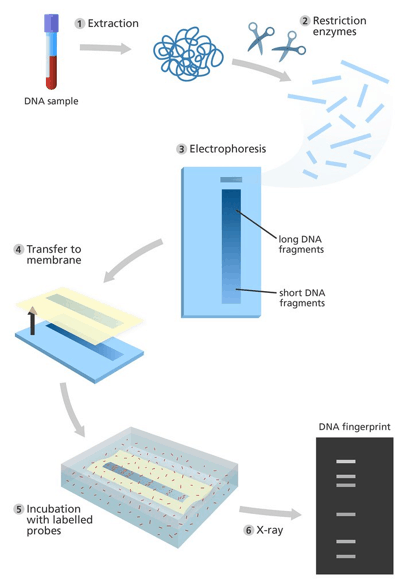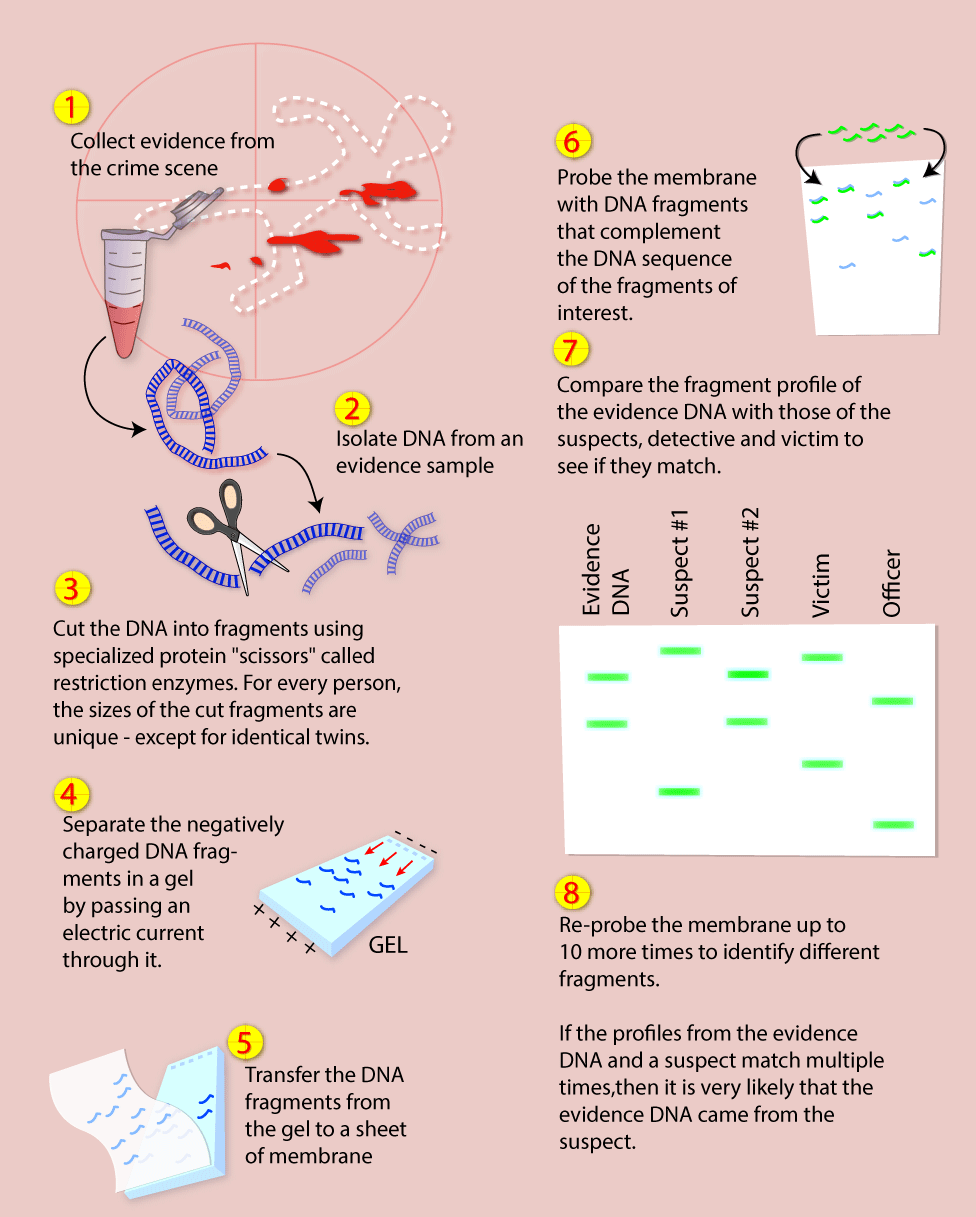At 94 C 2012 F the double-stranded DNA melts and opens into two pieces of single-stranded DNA. DNA fingerprinting is a method to analyse DNA found in biological materials.

What Is Dna Fingerprinting What Can Be Discovered In Your Code
The DNA testing process is comprised of four main steps including extraction quantitation amplification and capillary electrophoresis.

. The second step is annealing the primer to a specific target sequence of DNA. List one reason why the body needs to make more cells. Human genome possesses numerous small non-coding but inheritable sequences of bases which are repeated many times.
Restriction Absorption Enhancement or DNA Sequencing. It is the creation of thousands to millions of copies of a particular DNA sequence. Several basic steps are performed during DNA testing regardless of the type of test being done.
During criminal investigations the hair semen or blood of the suspect is collected for further analysis. I restriction endonuclease digestion of genomic DNA and the ligation of specific adapters. The polymerase chain reaction PGR amplifies a single piece of DNA across several orders of magnitude see figure 62.
1 the isolation of the DNA from an evidence sample containing DNA of unknown origin and generally at a later time the isolation of DNA from a sample eg blood from a known. The polymerase chain reaction process serves to raise the number of DNA fragments. Separating the digested fragments as per the fragment size by the process of electrophoresis.
Three regular strategies are utilized. The next step is to extract the DNA sample from its source. Iii analysis of the amplified fragments using gel electrophoresis.
Following are the steps involved in DNA fingerprinting. Annealing Primer to Target Sequence 3. Overview of Steps in Analyzing DNA Evidence.
PGR is a three-step process or cycle. To amplify a segment of DNA using PCR the sample is first heated so the DNA denatures or separates into two pieces of single-stranded DNA. Extraction DNA is located within the nucleus of cells throughout the body and the extraction step is responsible for breaking open the nucleus and releasing the DNA molecules into solution.
Ii amplification of the restriction fragments by PCR using primer pairs containing common sequences of the adapter and one to three arbitrary nucleotides. Describe the selectivity of the PCR. Describe the three main steps in DNA profiling using PCR.
In RFLP DNA is first extracted from the cell and then divided into fragments by restriction enzymes. Explain why as many as 10 STR sites are used to gain a DNA profile for forensic evidence. If you do not there is a high probability of confusion and frustration.
Get Your Custom Essay on 3. It is done by Restriction Fragment Length Polymorphism RFLP. In this step the two strands of double-stranded DNA are separated by heating to 94C for 2 minutes.
Up to 24 cash back The process of DNA fingerprinting starts with isolating DNA from any part of the body such as blood semen vaginal fluids hair roots teeth bones etc. Principle of DNA Fingerprinting. State the function of the PCR.
DNA can also be collected directly from a person using a mouth swab which collects inner cheek cells. End of the First PGR Cycle. Describe the three main steps in DNA profiling using PCR.
In many situations there is only a small amount of DNA available for DNA fingerprinting. Outline the process of DNA profiling. RFLP based STR investigation.
Next an enzyme called Taq polymerase synthesizes - builds - two new strands of DNA. Find out more in the articles Forensics and DNA and Crime scene evidence. OBlozone International 2001-2008 Photocopying Prohibited.
OBlozone International 2001-2008 Photocopying Prohibited Dont use plagiarized sources. Digesting the DNA with the help of restriction endonuclease enzymes. The PCR cycle has following three steps.
There are problems with RFLP method notably that a relatively large amount of DNA is needed. A _____ b. Two animations Making many copies of DNA and PCR animation are very useful DNA Profiling Activity Paternity Case Before starting this activity watch the DNA Profiling animation New Methods of DNA Profiling using PCR and STRs Short Tandem Repeats.
What are the three main parts of the cell cycle. A _____ b _____ c. Describe the three main steps in DNA profiling using PCR bI 4.
Hybridising the fragments using labelled VNTR probes. 35U4 Genetic modification is carried out by gene transfer between species. 3 basic steps of PCR process.
The polymerase chain reaction is composed of four primary steps. Chemicals are added to break open the cells extract the DNA and isolate it from other cell components. During interphase DNA do what before mitosis can occur.
The extraction process is devised in a. Find step-by-step Biology solutions and your answer to the following textbook question. Following are the steps involved in DNA fingerprinting.
PCR cycles can be repeated until the sample DNA has been copied many times in the lab if necessary. There are three major steps in the AFLP procedure. The DNA of every human being on the planet is 999 same.
What is uncoiled stringy DNA called. Blotting the separated fragments onto synthetic membranes like nylon. Denaturation by Heat 2.
The two strands separate because the hydrogen bonds between the base pairs break. The first step is denaturation using heat. This source could be a single strand of hair semen blood a single drop will work too saliva cheek cell etc.
Nucleotides and DNA polymerase enzymes are added along with primer pieces of DNA which will bind to the sample DNA and give the polymerases a starting point. 35U2 PCR can be used to amplify small amounts of DNA. The polymerase chain reaction is a three step cycling process consisting of defined sets of times and temperatures.
PCR based investigation. 35U3 DNA profiling involves comparison of DNA. 3 basic PCR steps include.
Polymerase chain reaction PCR is the next step in the process. The PCR method of DNA fingerprinting. However about 01 or 3 x 106base pairs out of 3 x 109 bp of DNA is unique in every individual.
Each step -- denatauration alteration of structure annealing joining and extension -- takes place at a different temperature. To begin with one should have a source of DNA sample. DNA is contained within the nucleus of cells.
Describe the three main steps in DNA profiling using PCR bI 4. The general procedure includes. 1 Answer to 3.
Explain why as many as 10 STR sites are used to gain a DNA profile for forensic evidence. The method that has replaced forensic DNA fingerprinting is based on the polymerase chain reaction which greatly amplifies the small amounts DNA that may exist at a crime scene. End of the first cycle.
Describe the three main steps in DNA profiling using.



0 Comments